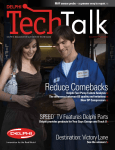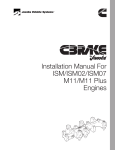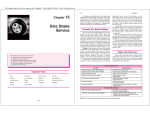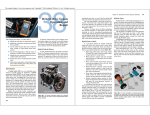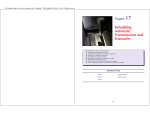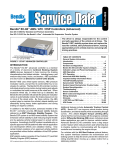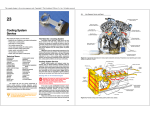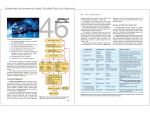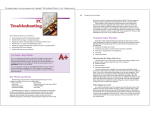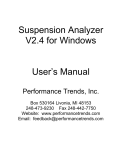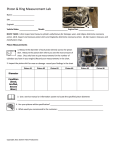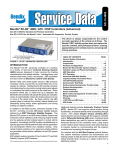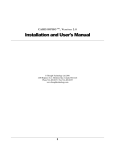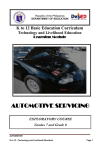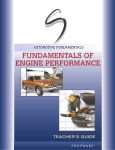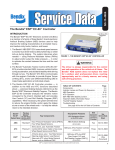Download Chapter 1 - Goodheart
Transcript
This sample chapter is for review purposes only. Copyright © The Goodheart-Willcox Co., Inc. All rights reserved. Chapter 1 Review of Engine Operation After studying this chapter, you will be able to: K List the major parts of an automotive engine. K Explain the purpose of major engine parts and assemblies. K Describe the relationship between the major parts of an engine. K Summarize the four-stroke cycle. K List and describe the related systems of an engine. Know These Terms BDC Engine block Piston pin Camshaft Engine valves Piston rings Charging system Exhaust gas recirculation system Ports Combustion Computer system Connecting rod Control module Cooling system Crankcase Crankshaft Cylinder Cylinder block Cylinder head Drive train Emission control systems Exhaust manifold Positive crankcase ventilation system Four-stroke cycle Spark plug Fuel system Starting system Gasoline injection TDC Ignition system Throttle valve Intake manifold Valve guides Internal combustion engine Valve seats Lubrication system Valve springs Main bore Valve train Oil galleries Water jackets Piston Water pump 9 10 Auto Engine Repair This chapter provides a quick review of the operating principles of a four-stroke-cycle, piston engine. The interaction of basic engine components are discussed. Related systems—cooling, lubrication, fuel, computer control, and other systems—are explained. This review will prepare you for later text chapters that discuss these topics in much more detail. This chapter uses words and illustrations to construct a basic, one-cylinder engine. You will see how each part is installed in the basic engine and learn how that part performs an important function. Then, near the end of the chapter, the systems that supplement engine operation and protect the engine from damage are reviewed. If you have completed an introductory course that covered engine operation, you should still read through this chapter to refresh your memory. If you are not familiar with the operation of an engine, study this chapter carefully. This will let you catch up with the students that have already had some training in engines. Chapter 1 Review of Engine Operation 11 K The connecting rod connects the piston to the crankshaft. Automotive Engine An engine is the source of power for moving the vehicle and operating the other systems. Sometimes termed the power plant, it burns a fuel (usually gasoline or diesel fuel) to produce heat, expansion of gasses, pressure, and resulting part movement. Since a vehicle’s engine burns fuel inside of itself, it is termed an internal combustion engine. As you will learn, the arrangement of an engine’s parts allows it to harness the energy of the burning fuel. Figure 1-1 illustrates the major parts of a modern, multi-cylinder engine. Study them as they are introduced: K The block is the supporting structure for the engine. K The piston slides up and down in the block. K The piston rings seal the space between the block and sides of the piston. Camshaft Intake manifold Valve spring K The crankshaft converts the up and down action of the piston into rotary motion. K The cylinder head fits over the top of the block and holds the valves. K The valves open and close to control fuel entry into and exhaust exit from the combustion chamber. K The combustion chamber is a cavity formed above the piston and below the cylinder head for containing the burning fuel. K The camshaft opens the valves at the proper time. K The valve springs close the valves. K The timing belt or chain turns the camshaft at one-half of the engine speed. Engine Block The engine block, also called the cylinder block, forms the framework or “backbone” of an engine. This is because many of the other components of an engine fasten to the block. Cast from iron or aluminum, the block is the largest part of an engine. Figure 1-2 shows a cutaway view of a basic engine block. Note the part names. A cylinder is a large hole machined through the top of the engine block. The piston fits into the cylinder. During engine operation, the cylinder, also called the cylinder bore, guides the piston as it slides up and down. The cylinder is slightly larger than the piston to produce a clearance (space) between the two parts. Main caps are bolted to the bottom of the block. They hold the crankshaft in place and form the bottom half of the main bore. The main bore is a series of holes machined from the front to the rear of the block. The crankshaft fits into these holes. With the engine running, the crankshaft spins or rotates in the main bore. The deck is a flat surface machined on the top of the block for the cylinder head. The head is bolted to the deck. Coolant and oil passages in the deck align with openings in the cylinder head. Coolant passages, or water jackets, surround the cylinders and combustion chamber. They are hollow areas inside the block and head for coolant. Coolant circulated through the water jackets removes the heat generated by the fuel burning in the cylinders. The crankcase is the lower area of the block. The crankshaft spins inside the crankcase. Piston The piston converts the pressure of combustion into movement. See Figure 1-3. Combustion is the burning of Deck Valve Cylinder head Water jacket Piston slides up and down in cylinder Cylinder Timing chains Cylinder block Crankcase Main bore Block Combustion chamber Exhaust manifold Crankshaft pulley Piston Crankshaft Oil pan Piston rings Connecting rod Figure 1-1. Study the general location of parts in an engine.This will help you while reviewing the operation of an engine in this chapter. (Ford) Main caps Main bolts Figure 1-2. The block is the framework for holding the other engine components. Note the parts of the block. This is a simplified, one-cylinder engine. Figure 1-3. The piston fits into a cylinder bored through the block. The piston slides up and down during engine operation acting as a pumping and power-producing element. 12 Auto Engine Repair Combustion pressure Ring tension Compression ring The piston rings fit into grooves machined into the sides of the piston. These rings keep combustion pressure from entering the crankcase and engine oil from entering the combustion chamber. Look at Figure 1-4. The compression rings seal the clearance between the block and piston. They are normally the two upper piston rings. Their job is to contain the pressure formed in the combustion chamber, Figure 1-5. Without compression rings, pressure would blow past the outside diameter of the piston and into the lower area of the engine block. The oil ring fits into the lowest groove in the piston. It is designed to scrape excess oil from the cylinder wall to keep it from being burned in the combustion chamber, Figure 1-6. If oil enters the area above the piston and burns, blue smoke blows out of the tailpipe. Review of Engine Operation 13 Connecting Rod fuel, which results in expanding gas inside the cylinder. The piston transfers the pressure of combustion to the piston pin, connecting rod, and crankshaft. It also holds the piston rings and piston pin. During engine operation, the piston slides up and down in the cylinder at tremendous speeds. At a vehicle speed of about 55 mph (88 km/h), the piston can accelerate from zero to 60 miles an hour and then back to zero in one movement from top to bottom in the cylinder. This places tremendous stress on the piston and its related parts. Piston Rings Chapter 1 Cylinder wall Piston Figure 1-5. The compression rings use combustion pressure to help seal against the cylinder wall. This keeps pressure in the combustion chamber and out of the crankcase. Cylinder wall Piston Ring groove Oil control ring The connecting rod transfers the force of the piston to the crankshaft. It is fastened to the piston pin at the top and the crankshaft at the bottom. It also causes piston movement on nonpower-producing events (up and down piston movements). See Figure 1-8. The small, top end of the connecting rod has a hole machined in it for the piston pin. The top of the rod extends inside of the piston. The big, bottom end of the connecting rod fits around the crankshaft journal. It has a removable cap that allows the installation and removal of the rod-piston assembly. Special rod bolts and nuts hold the cap in place. As discussed in later chapters, bushings are normally installed in the small end of the rod. Rod bearings are installed in the big end of the connecting rod. Crankshaft A piston pin, also called a wrist pin, allows the connecting rod to swing back and forth inside the piston. The pin fits through a hole machined in the piston and through a hole in the upper end of the connecting rod. Refer to Figure 1-7. Piston clearance Piston clearance Oil film Oil to crankcase Figure 1-6. Oil rings act as a scraper to keep oil out of the combustion chamber. (Deere & Co.) Piston head Piston diameter Figure 1-9. The crankshaft takes the reciprocating motion of the piston and produces rotary motion for vehicle’s drive train and accessory system. Connecting rod I-beam Big end for rod bearing Piston at bottom dead center Rod bolt Rod cap Rod and its crankshaft journal up Piston pin Compression rings Piston Piston pin bore Oil ring Figure 1-4. The clearance between the piston and cylinder allows the piston to move freely in the cylinder. Rings seal the clearance. Counterweight Piston pin Rod nut Piston pin Snout Piston at top dead center Small end Ringlands Flywheel flange Main journals The crankshaft converts the up and down (reciprocating) movement of the connecting rod and piston into rotary motion. The rotary motion is used to power gears, chains, belts, and the drive train. The crankshaft fits into the main bore of the engine block, as shown in Figure 1-9. It mounts on the main bearings and is free to spin inside the block. The connecting rods are attached to the crankshaft journals. Figure 1-10 Escaping oil Piston Pin Rod journal Connecting rod Swinging action Figure 1-7. The piston pin fits into a hole bored in the piston. The pin attaches the piston to the connecting rod. Figure 1-8. The connecting rod links the piston and crankshaft together. The large end has a removable cap that allows the rod to be bolted around the crankshaft journal. The small end has a hole for the piston pin. Rod and its crankshaft journal down Figure 1-10. Note how the crankshaft changes the reciprocating motion of the piston into rotary motion. 14 Auto Engine Repair shows how the crankshaft changes the reciprocating (up and down) motion of the piston and connecting rod into a rotary motion. The engine flywheel is a very heavy, round disk mounted to the back of the crankshaft. It helps to keep the crankshaft spinning between power strokes and smooth engine operation. It also holds a large gear used by the starter. TDC and BDC The abbreviation TDC stands for top dead center. This is the point of travel where the piston is at its highest point in the cylinder. The abbreviation BDC stands for bottom dead center. This is the point of travel where the piston is at its lowest point in the cylinder. Refer to Figure 1-11. Crankshaft Piston One-half revolution 180° One stroke Review of Engine Operation 15 Cylinder Head The cylinder head is bolted to the top of the block deck to enclose the top of the cylinders and form the top of the combustion chamber, Figure 1-12. Like the block, the cylinder head contains water jackets for cooling and oil passages for lubricating moving parts on or in the cylinder head. Valve guides are machined through the top of the head for the valves. The valves slide up and down in these guides. Cylinder head ports are passages for the air-fuel mixture to enter the combustion chamber and for exhaust gasses to flow out of the engine. These are located in the cylinder head. Valve seats are machined in the opening where the ports enter the combustion chamber. The valves close against the seats to make a leakproof seal at high temperatures. Engine Valves Top dead center (TDC) Chapter 1 Engine valves control the flow into and out of the engine cylinder or combustion chamber. They fit into the cylinder head, operate inside the valve guides, and close on the valve seats. Valve springs fit over the top end of the valves to keep the valves in a normally closed position, Figure 1-13. Figure 1-14 shows how a valve opens and closes the ports in the cylinder head. When the valve slides down, the valve head moves away from the valve seat and the port is opened. When the valve slides up, the valve head moves toward the valve seat until the valve face makes contact with the valve seat. This seals the combustion chamber from the port. Cylinder head Valve guides Exhaust port TDC Air-fuel mixture Valve springs Exhaust port Intake port Exhaust valve Intake valve Intake valve open Figure 1-13. Valves fit into guides in the cylinder head. Valve springs hold the valves closed. The valves seal against valve seats in the head to close off ports from the combustion chamber. There are two types of valves—intake and exhaust. The intake valve is the larger valve and it allows a fuel charge to flow into the cylinder. The exhaust valve is the smaller valve and it opens to let burned gasses (exhaust) out of the cylinder. Figure 1-15 shows how the air-fuel mixture flows through the intake port, past the valve, and into the combustion chamber when the valve is open. Four-Stroke Cycle The four-stroke cycle needs four up or down piston movements, or strokes, to produce one complete cycle. Every two up and two down strokes of the piston results Cylinder head Valve guide Intake port Water jacket Exhaust valve seat Port Intake valve seat Valve face Valve head Figure 1-14. Study the valve action. When the valve slides open, the valve face is lifted off of the valve seat. This opens the port to the combustion chamber and gasses are free to enter or exit the cylinder. Connecting rod Figure 1-11. TDC is when the piston is at the top of its stroke. BDC is when the piston is at the bottom of its stroke. One stroke is the piston movement from TDC to BDC or vice versa. (Ford) Margin Valve seat Figure 1-12. The cylinder head is bolted to the top of the block. It forms a cover over the cylinder. The head also holds the valves that control flow into and out of the cylinder. Figure 1-15. Note the action as the intake valve opens. Downward movement of the piston forms a vacuum in the cylinder. Atmospheric pressure pushes the air-fuel charge into the cylinder. (Ford) in one power-producing cycle. Two complete revolutions of the crankshaft are needed to complete one four-stroke cycle. Automotive engines, both gas and diesel, are four-stroke-cycle engines. The four strokes are intake, compression, power, and exhaust. With the engine operating, these strokes happen over and over very rapidly. At idle, an engine might be running at 800 revolutions per minute (rpm), which means the crankshaft rotates 800 times in one minute. Since it takes two complete revolutions of the crankshaft to complete a four-stroke cycle, an engine completes 400 four-stroke cycles per minute at idle. In other words, the piston must slide up 800 times and down 800 times per minute. You can imagine how fast these events are happening at highway speeds! Intake Stroke BDC Bottom dead center (BDC) Port in cylinder head A gasoline engine’s intake stroke draws air and fuel into the combustion chamber. Figure 1-16A shows the basic action during the intake stroke. Study the position of the valves and movement of the piston. The piston slides down to form a vacuum (low pressure area). The intake valve is open and the exhaust valve is closed. Atmospheric pressure (outside air pressure) pushes the air-fuel charge into the vacuum in the cylinder. This fills the cylinder with a burnable mixture of fuel and air. Compression Stroke The compression stroke squeezes the air-fuel mixture to make it more combustible. See Figure 1-16B. Both the intake and exhaust valves are closed. The piston slides up and compresses the mixture into the small area in the combustion chamber. 16 Auto Engine Repair Air-fuel mixture pulled into cylinder Exhaust valve closed Chapter 1 Review of Engine Operation 17 For proper combustion (burning), it is very important that the valves, rings, and other components do not allow pressure leakage out of the combustion chamber. Leakage during the compression stroke may prevent the mixture from igniting and burning on the power stroke. The camshaft opens the valves and allows the valve springs to close the valves at the proper times. The camshaft has a series of lobes (egg-shaped bumps) that act on the valves or valve train to slide the valve down in its guide. See Figure 1-18. Power Stroke Exhaust valve closed Intake valve open Intake valve closed Pressure formed on fuel charge Piston and rod moving down A—Intake Stroke Piston and rod moving up Both valves are closed and the piston slides up. This compresses the air-fuel charge and prepares it for combustion. Spark plug fires Intake valved closed Exhaust valve closed Intake valve closed Burned gasses pushed from cylinder The exhaust stroke pushes the burned gasses out of the cylinder and into the vehicle’s exhaust system. See Figure 1-16D. The intake valve remains closed, but the exhaust valve is open. Since the piston is now moving up, the burned gasses are pushed out of the exhaust port to ready the cylinder for another intake stroke. Valve Train The valve train operates the engine valves. It times valve opening and closing to produce the four-stroke cycle. Basic valve train parts are shown in Figure 1-17. Air-fuel mixture burns, expands, and forms pressure Exhaust valve open Piston and rod pushed down to turn crankshaft Camshaft Exhaust Stroke B—Compression Stroke The piston slides down with the intake valve open and the exhaust valve closed. The air-fuel charge is pulled into the cylinder. Cam lobes The air-fuel mixture is ignited and burned during the power stroke to produce gas expansion, pressure, and a powerful downward piston movement. See Figure 1-16C. Both valves are still closed. The spark plug fires and the fuel mixture begins to burn. As the mixture burns, it expands and builds pressure in the combustion chamber. Since the piston is the only part that can move, it is thrust downward with several tons of force. This downward thrust pushes on the connecting rod and crankshaft forcing the crankshaft to turn. The power stroke is the only stroke that does not consume (use) energy. Rocker arm pushes down Pivot point Piston and rod moving up Figure 1-18. The lobes on the camshaft act on the valves or valve train to open and close the valves. As shown here, the camshaft fits into the cylinder head on many engines. This lets it operate directly on valves without using push rods. Rocker arm pushed up by spring Spring Valve closed on seat C—Power Stroke The spark plug fires and the fuel begins to burn. The heat of combustion causes expansion of the gasses and creates pressure. This pushes the piston down with tremendous force to spin the crankshaft. Push rod D—Exhaust Stroke The piston slides up with the intake valve closed and the exhaust valve open. This pushes the exhaust gasses out of the cylinder so a fresh charge can enter. Figure 1-16. Review the four-stroke cycle. You must be able to visualize these events to be a competent engine technician. Valve pushed off seat Cam lobe touches lifter Valve open Lifter (tappet) Lobe away from lifter Valve closed Figure 1-17. The camshaft operates the valve train. When the cam lobe rotates into a lifter, the valve is opened. When a lobe moves out of a lifter, the valve spring closes the valve. (Ford) 18 Auto Engine Repair In Figure 1-17, note how the cam lobe acts on the valve train. When the lobe moves into the lifter, the lifter, pushrod, and one side of the rocker arm are pushed up. This opens the valve. When the lobe rotates away from the lifter, the valve spring pushes the valve and other parts into the closed position. Camshaft timing is needed to ensure that the valves properly open and close in relation to the crankshaft. Either a belt, chain, or set of gears is used to turn the camshaft at one-half of the crankshaft speed and keep the camshaft in time with the crankshaft. Figure 1-19 shows how a timing belt is used to operate the camshaft on our basic engine. Note: With multiport fuel injection, the fuel is injected into the airstream at the port. However, the fuel is injected into the airstream at the beginning of the intake manifold (in the throttle body) with throttle body injection. Review of Engine Operation 19 Air Camshaft sprocket Throttle body Intake manifold Intake runners Valve cover Timing belt Exhaust port Exhaust manifold Adjuster pulley Figure 1-20. This is a cutaway of an engine. Note the intake and exhaust manifolds. Ports in the intake manifold connect to the intake ports in the cylinder head. The exhaust manifold is bolted over the exhaust ports in the cylinder head. (General Motors) Crankshaft sprocket bearings, camshaft bearings, and valve train components. These are high-friction points in the engine and need oil for protection. Cooling System The cooling system is needed to carry the heat of combustion and friction away from the engine. Without a cooling system, the piston, valves, cylinder, and other parts could be ruined in a matter of minutes. The head and block could also crack from the tremendous heat. Basically, a cooling system consists of a radiator, water pump, fan, thermostat, water jackets, and connecting hoses, Figure 1-21. The water pump circulates an antifreeze and water solution through the water jackets, hoses, and radiator. It is often driven by a fan belt running off of the crankshaft pulley, but may be driven by an electric motor. The coolant (antifreeze-water solution) picks up heat from the metal parts of the engine and carries it to the radiator. The radiator transfers heat from the coolant to the outside air. A fan is used to pull air through the radiator. Large radiator hoses connect the radiator to the engine. The thermostat is a temperature-sensing valve that controls the operating temperature of the engine. When the engine is cold, the thermostat blocks coolant flow through the radiator and speeds warm-up of the engine. Fuel injector Intake port Intake and Exhaust Manifolds The intake manifold carries the air-fuel mixture into the cylinder head intake ports. It normally is bolted to the cylinder head. Ports in the intake manifold match the intake ports in the cylinder head. The exhaust manifold, as its name implies, carries burned gasses from the cylinder head exhaust port to the other parts of the exhaust system. Figure 1-20 shows the basic action of the intake and exhaust manifolds. Chapter 1 Figure 1-19. The camshaft is turned at one-half of engine speed. A timing belt is the most common method of turning the camshaft in time with the crankshaft rotation. Note the part names. When the engine is warm, the thermostat opens to allow coolant to circulate through the radiator, thus removing heat from the engine. Lubrication System The lubrication system circulates engine oil to highfriction points in the engine. Without oil, friction will result in wear, scoring, and damage to parts very quickly. The lubrication system basically consists of an oil pump, oil pickup, oil pan, and oil galleries. See Figure 1-22. The oil pump is the “heart” of the lubrication system because it circulates oil through the oil galleries. The oil galleries are small passages that lead to the crankshaft Ignition System An ignition system is needed on a gasoline engine to ignite and burn the air-fuel mixture. It must increase battery voltage enough to produce a high-voltage electric arc, or “spark,” at the tip of each spark plug in the combustion chamber. Refer to Figure 1-23. A fundamental ignition system consists of a spark plug, plug wire, ignition coil, switching device, and power source. On many late-model vehicles, the ignition coil is mounted directly on top of the spark plug eliminating the need for a spark plug wire. The switching device in the ignition system is an electronic control unit that makes and breaks electrical current flow to the ignition coil(s). Ignition coil operation is timed with crankshaft rotation so that the spark occurs in the combustion chamber at the end of the compression stroke. The ignition coil is used to step up battery voltage to over 60,000 volts. This is enough voltage to make the electricity jump the spark plug gap. The ignition coil fires every time the switching device stops current flow from the battery, Figure 1-23. This causes the magnetic field in the coil to collapse and induce a higher voltage in the coil’s output wire. The spark plug is the “match” that starts the air-fuel mixture burning in the combustion chamber. When ignition coil fires and sends current through the spark plug wire, an electric arc (spark) forms at the tip of the spark plug. This makes the fuel and air start to burn, producing the power stroke. Note: Older ignition systems used a mechanical switching device called points. Ignition systems with points have not been used on production vehicles since the mid 1970s. If you encounter this type of ignition system, refer to the appropriate service manual for service procedures. Starting System The starting system turns the engine crankshaft until the engine can begin running on its own power. It uses a battery, ignition switch, high-current relay, and electric motor to rotate the crankshaft, Figure 1-24. 20 Auto Engine Repair Chapter 1 Spark plug wire Hot coolant Radiator Battery Spark plug Fan Airflow to remove heat from coolant Engine water jacket Combustion Electronic control unit or switching device Cooled coolant Fan belt Figure 1-21. A cooling system is needed to remove heat from the engine and prevent severe engine damage. Water jackets allow coolant to flow around the cylinders and through the cylinder head. A water pump circulates coolant through the system. The radiator dissipates heat into the outside air. A fan pulls air through the radiator. (DaimlerChrysler) Oil to valve train Speed sensing device or pickup coil Figure 1-23. The ignition system is used on a gasoline engine to ignite the fuel in the combustion chamber. A coil produces high voltage for the spark plug. When the switching device breaks the flow of current to the coil, the coil and spark plug fire to ignite the fuel. The battery stores chemical energy that can be changed into electrical energy. When the driver turns ignition switch (start switch), the solenoid (high-current relay) sends battery current to the starter motor. The starter motor has a small gear that engages a large gear on the crankshaft flywheel. The motor has enough torque (turning force) to spin the flywheel, and thus the crankshaft, until the engine starts and runs. Then, the driver releases the ignition key and deactivates the starting system. Oil filter Wiring harness Main fuse Oil dipstick Oil gallery Gasoline Injection System The charging system is needed to recharge (re-energize) the battery after starting system or other electrical system operation. The battery can become discharged (run down) after only a few minutes of starter motor operation. The charging system also provides all of the vehicle’s electrical needs while the engine is running. Basically, the charging system consists of the alternator and a voltage regulator. Look at Figure 1-25. The alternator produces the electricity to recharge the battery. It is driven by a belt from the engine crankshaft pulley. The alternator sends current through the battery to reactivate the chemicals in the battery. This again prepares the battery for starting or other electrical loads. The voltage regulator controls the electrical output of the alternator. It ensures that about 14.5 volts are produced by the alternator. Current then flows back into the battery, since battery voltage is only about 12.5 volts. Trigger wheel Crankshaft pulley 21 Charging System Ignition coil Water pump Review of Engine Operation Starter motor Flywheel ring gear Fuel System The fuel system must meter the right amount of fuel (usually gasoline or diesel oil) into the engine for efficient combustion under different conditions. At low speeds, it must meter a small amount of fuel into the airstream. As engine speed and load increase, the fuel system must meter more fuel into the airstream. The fuel system must also alter the fuel metering with changes in engine temperature and other variables. There are two basic types of automotive fuel systems in current use—gasoline injection and diesel injection. A third type of fuel system—carburetion—has not been commonly used since the mid 1980s. Ignition switch Charging system wiring harness Main fuse Negative or ground cable Diesel Injection System Voltage regulator Oil pump Positive battery cable Oil to crank and camshaft Oil pan Figure 1-22. The lubrication system prevents excess friction that may damage the engine. Note the part names. (DaimlerChrysler) Charge indicator Starter cable Alternator Starter solenoid Figure 1-24. The starting system rotates the crankshaft until the engine starts. A powerful electric starter motor has a gear that meshes with the gear on the engine flywheel. A solenoid makes the electrical connection between the battery and the starter motor when the ignition key is turned to the start position. (Honda) Battery A gasoline injection system uses fuel pump pressure to spray fuel into the engine intake manifold, usually near the cylinder head’s intake port. A basic system is pictured in Figure 1-26. An electric fuel pump forces fuel from the fuel tank to the fuel injector. A constant pressure is maintained at the injector. The fuel injector is simply an electrically-operated fuel valve. When energized by the control module, it opens and squirts fuel into the intake manifold or the combustion chamber. When not energized, it closes and prevents fuel entry into the engine. Modern gasoline injection systems open the injector when the engine intake valve opens. Then, fuel is partially or completely forced into the combustion chamber by pump pressure. This helps control how much fuel enters the cylinder and also increases combustion efficiency, as you will learn in later chapters. A control module (computer) is used to regulate when and how long the injector opens. It uses electrical information from various sensors to analyze the needs and operating conditions of the engine. The engine sensors monitor various operating conditions, such as engine temperature, speed, load, and so on. In this way, the computer can determine whether more or less fuel is needed and whether the injector should be opened for a longer or shorter period of time based on the current operating conditions. A throttle valve controls airflow, engine speed, and engine power. It is connected to the accelerator pedal. When the pedal is pressed, the throttle valve opens to allow more air into the combustion chambers. In turn, the control module holds the injectors open for a longer period of time, allowing more fuel into the combustion chamber. The increase in air and fuel results in an increase in engine power output. As the accelerator pedal is released, the throttle valve closes, reducing the amount of air allowed into the combustion chamber. The control module, in turn, reduces the amount of time the injectors are open, thus reducing the amount of fuel released into the injection chamber. The decrease in air and fuel results in a decrease in engine power output. Alternator belt Figure 1-25. The charging system recharges the battery and provides the vehicle’s electrical needs while the engine is running. (Honda) A diesel injection system forces fuel directly into the engine’s combustion chamber, as shown in Figure 1-27. The heat resulting from highly compressed air, not an electric spark plug, ignites and burns the fuel. When the intake valve opens, a full charge of air is allowed to flow into the cylinder. Then, on the compression stroke, the air is squeezed until it is at a high temperature. As soon as the fuel is injected into the hot air, the fuel burns and expands. A diesel injection system basically consists of an injection pump, injector, and glow plug system. The injection pump is a high-pressure, mechanical pump. It is powered by the engine and forces fuel to the diesel injector under very-high pressure. A conventional fuel pump feeds fuel from the tank to the injection pump. 22 Auto Engine Repair Chapter 1 Review of Engine Operation Fuel injector (fuel valve) sprays fuel toward intake valve when open 23 Air enters filter Fuel line Carburetor Spark plug ignites mixture Low-pressure mechanical fuel pump Air enters Throttle valve Electric fuel pump Gasoline from tank Wires to engine sensors Control module Fuel pulled into airstream by vacuum Throttle controls airflow and engine speed Fuel from tank Mixture ignited by spark plug Figure 1-28. Carburetion systems are not used on passenger vehicles, but are still used on small gas engines. In this type of system, airflow into engine pulls fuel out of carburetor’s fuel bowl. A mechanical fuel pump fills the fuel bowl with fuel, but does not force the fuel into the intake manifold. Air-fuel mixture flows to cylinder Figure 1-26. Gasoline injection uses pressure from an electric fuel pump to spray fuel into engine intake manifold through fuel injectors. A throttle valve is used to control the airflow into the engine. Computer System The diesel injector is simply a spring-loaded valve. It is normally closed and blocks fuel flow. However, when the injection pump forces fuel into the injector under high pressure, the injector opens. The fuel is sprayed directly into the combustion chamber or a precombustion chamber. This is called a direct injection system. Note in Figure 1-27 that a diesel does not have a throttle valve or a spark plug. Engine power and speed are controlled by the injection pump, which is controlled by a control module. The more fuel injected into the combustion chamber, the more speed and power are produced by the engine. As less fuel is injected into the combustion chamber, engine speed and power decrease. A glow plug system is used to aid cold starting of a diesel engine. The glow plug is an electric heating element that warms the air in the combustion chamber. This helps the air become hot enough to start combustion until the heat from engine operation can warm the incoming air. Carburetion Fuel System Instead of injecting fuel into the airstream or combustion chamber, a carburetion system uses engine vacuum (suction) to pull fuel into the engine, Figure 1-28. Airflow through the carburetor and the vacuum created by the engine’s intake stroke draw fuel out of the carburetor’s fuel bowl. As the throttle valve is opened, more air flows through the carburetor and, thus, more fuel flows into the airstream. A low-pressure, mechanical fuel pump draws fuel from the tank and delivers it to the carburetor’s fuel bowl. The carburetion system is not currently used on latemodel vehicles but is still found on small gas engines. A computer system is used to increase the overall efficiency of a vehicle. The computer, or control module, can control the ignition system, fuel system, transmission or transaxle, emission control systems, and other systems. Figure 1-29 shows a diagram of a simplified vehicle computer system. A modern vehicle may have several control modules. To understand how a vehicle’s computer control system works, think of the human body’s central nervous system. For example, if your finger touches a hot stove, the nerves (sensors) in your hand send a signal to your brain. Your brain (control module) analyzes these signals and decides that you are in pain. Your brain (control module) quickly activates your muscles (actuators) to pull your hand away from the hot stove. A computer control system works in the same manner. It controls actions based on sensory inputs. For simplicity, a vehicle’s computer control system can be divided into three subsystems: sensor, control, and actuator. The sensor subsystem checks various operating conditions using sensors. A sensor is a device that can Knock sensor Mass airflow sensor Fuel injectors Mechanical injection nozzle sprays fuel into combustion chamber Air enters Oxygen sensor Injection line Manifold absolute pressure sensor Fuel ignites as it touches hot air Intake air temperatue sensor Fuel pressure regulator Control module Engine coolant temperature sensor High-pressure mechanical pump Engine speed sensor No throttle valve Fuel pump Only air flows past intake valve and into combustion chamber Air compressed so tight it becomes red hot Diesel fuel from tank Figure 1-27. Diesel injection is primarily mechanical. A mechanical injection pump forces fuel into a spring-loaded injector nozzle. The pressure opens the injector and fuel sprays directly into combustion chamber. A diesel does not use a throttle valve or spark plug. Throttle position sensor Catalyst monitor Figure 1-29. This is a simplified diagram of the sensor, control, and actuator subsystems of a computer control system for fuel injector operation. 24 Auto Engine Repair change its electrical signal based on a change in a condition. Sensors might measure intake manifold vacuum, throttle opening, engine speed, transmission gear position, road speed, turbocharger boost pressure, and other conditions. The sensing system sends different electrical current values back to the control module. The control subsystem looks at the inputs from the sensors and determines what actions need to take place. A control module, or computer, contains miniaturized electrical circuits that collect, store, and analyze information. The control module then provides signals to the actuator subsystem. The actuator subsystem serves as the “hands” of the computer system. Based on signals from the control module, this system moves parts, opens injectors, closes the throttle, turns on the fuel pump, and performs other tasks needed to increase the overall efficiency of the vehicle. Electric motors, solenoids or relays, and switches are the actuators. The actuators turn on or off, open or close, or change position based on the signals from the control module. This is discussed in detail later in this textbook. Emission Control Systems Emission control systems are designed to reduce the amount of harmful chemicals and compounds (emissions) that enter the atmosphere from a vehicle. There are several types of emission control systems: K PCV. The positive crankcase ventilation system pulls fumes from the engine crankcase into the intake manifold so they can be burned before entering the atmosphere. K Evaporative emissions control. This system uses a charcoal-filled canister to collect and store gasoline fumes from the fuel tank when the engine is not running. Air is drawn through the canister and into the intake manifold while the engine is running so the collected fumes are burned. K EGR. The exhaust gas recirculation system injects exhaust gasses into the engine to lower combustion temperatures and reduce one form of pollution in the engine exhaust. K Air injection. This system forces air into the exhaust stream leaving the engine to help burn any unburned fuel that exits the combustion chamber. K Catalytic converter. This device chemically converts byproducts of combustion into harmless substances. Many of these systems work together, all reducing their share of harmful emissions. The computer also plays an important part in reducing pollution. It improves the efficiency of many systems. Drive Train The drive train uses power from the engine to turn the vehicle’s drive wheels. Drive train configurations vary, but Chapter 1 Review of Engine Operation can generally be classified as rear-wheel drive or frontwheel drive. Figure 1-30 shows simplified drive trains. 25 Transmission Clutch Engine Clutch The clutch allows the driver to engage or disengage the engine power from the drive train. It is mounted onto the engine flywheel between the engine and transmission or transaxle. A clutch is needed when the vehicle has a manual transmission. A vehicle with an automatic transmission does not have a clutch. Engine Clutch Differential Manual transaxle Front drive axle Manual transmission Transmission The transmission uses a series of gears to allow the amount of torque going to the drive wheels to be varied. The driver can shift gears to change the ratio of crankshaft revolutions to drive wheel rotation. When first accelerating, more torque is needed to get the vehicle moving. Then, at higher road speeds, less torque is needed to maintain road speed. Engine speed also needs to be reduced at highway speeds. A manual transmission is shifted by hand. Levers, cables, or rods connect the driver’s shift lever to the internal parts of the transmission. An automatic transmission uses a hydraulic (fluid pressure) system to shift gears. A torque converter (fluid clutch) and special planetary gear sets provide automatic operation. However, the driver must manually change the shift lever position to change from forward to reverse. A transaxle is a transmission and a differential (axle drive mechanism) combined into one housing. It is commonly used with front-wheel-drive vehicles, but may also be found on rear-engine, rear-wheel-drive vehicles. A transaxle may be manual or automatic. Drive Shaft and Drive Axle A drive shaft is used with a front-engine, rear-wheeldrive vehicle. It connects the transmission to the differential. A drive axle connects the differential to the drive hubs or wheels. On most rear-wheel-drive vehicles, the drive axle is a solid steel shaft. On vehicles with a transaxle, the drive axle is a flexible shaft extending from the transaxle to the front wheel hubs. Summary This chapter reviewed the basic operation of a fourstroke-cycle, piston engine. The engine found in most vehicles is called an internal combustion engine because it burns fuel inside of combustion chambers. The cylinder block holds the other parts. The piston and connecting rod transfer combustion pressure to the crankshaft. The crankshaft converts the up and down action of the piston into rotary motion. Drive shaft Differential A Rear drive axle Dead axle B Figure 1-30. The drive train uses engine power and crankshaft rotation to turn the vehicle’s drive wheels. A—A front-engine, rear-wheel-drive vehicle. B—A front-engine, front-wheel-drive vehicle. Note the differential and transmission in one housing. The cylinder head is bolted on top of the cylinder block. It contains the valves that control flow into and out of the cylinder. The camshaft operates the valves so that they open and close to correspond to piston action, producing the four-stroke cycle. The intake stroke draws air-fuel mixture into the engine. The compression stroke squeezes the mixture and readies it for burning. The power stroke ignites the mixture and the expanding gasses push the piston down with tremendous force. The exhaust stroke purges the burned gasses to prepare the cylinder for another intake stroke. Every two crankshaft revolutions complete one fourstroke cycle. Thus, one power stroke is produced every two crankshaft revolutions. The flywheel helps keep the crankshaft spinning on the nonpower-producing strokes and smoothes out engine operation. Various systems are needed to keep the engine running. The cooling system removes excess combustion heat and prevents engine damage. The lubrication system also prevents engine damage by reducing friction between moving engine parts. The ignition system is needed on a gasoline engine to ignite the fuel and start it burning. A diesel engine uses high-compression-stroke pressure to heat the air in the cylinder enough to start combustion, instead of an electric spark. Also, a diesel does not use a throttle valve to control engine speed. The amount of fuel injected into the cylinder controls engine speed and power output. The two types of fuel systems in use today are gasoline injection and diesel injection. Modern fuel injection increases fuel economy over older fuel systems by closer control of the fuel use by each cylinder. Carburetion is not used today. The starting system uses a powerful electric motor to turn the engine flywheel until the engine can run on its own power. The charging system recharges the battery and supplies electricity to the vehicle while the engine is running. A vehicle’s computer system is similar to the human body’s central nervous system. The computer system monitors various conditions by analyzing input signals from sensors. Then, the control module (computer) determines what action should be taken to maintain maximum efficiency. Based on this, the control module sends signals to actuators that control the operation of the fuel system, ignition system, transmission, and other devices. Emission control systems reduce the amount of harmful pollutants that enter the atmosphere. Some emission control systems prevent fuel vapors from evaporating into 26 Auto Engine Repair the air. Others ensure complete combustion of fuel that leaves the combustion chamber and others just increase engine efficiency to reduce air pollution. The drive train transfers engine power to the drive wheels. Both front-wheel and rear-wheel drive are found on today’s vehicles. Front-wheel-drive vehicles have a transaxle, which is the transmission and differential combined in a single unit. Review Questions—Chapter 1 Please do not write in this text. Write your answers on a separate sheet of paper. 1. The _____ is the main supporting structure of an engine. 2. These hold the crankshaft in the bottom of the engine block. (A) Cam bearings. (B) Main caps. (C) Decks. (D) Rod bearings. ASE-Type Questions—Chapter 1 1. Technician A says an engine’s timing belt turns the camshaft at one-half of engine speed. Technician B says the camshaft opens the exhaust valve at the beginning of the power stroke. Who is correct? (A) A only. (B) B only. (C) Both A and B. (D) Neither A nor B. 2. Technician A says that the illustration is of a gasoline injection system. Technician B says that a diesel injection system injects fuel directly into the cylinder. Who is correct? (A) A only. (B) B only. (C) Both A and B. (D) Neither A nor B. 3. _____ surround the cylinders in most engines to provide a way for coolant to remove heat from the cylinders. 5. _____ keep combustion pressure from blowing into the crankcase and they also keep _____ out of the combustion chamber. 6. Why is a piston pin or wrist pin needed? 7. The crankshaft converts the _____ motion of the piston into rotary motion. 8. Describe the basic parts of a cylinder head. 10. Summarize the four-stroke cycle. 11. The _____ opens the valves and allows them to close. 12. Why are the cooling and lubrication systems important? 13. An electric ignition system can be found on a(n) _____ engine but not on a(n) _____ engine. 14. What are the two types of fuel systems in use today? 15. Describe the three basic subsystems in a computer control system. Review of Engine Operation 5. Technician A says the big end of a connecting rod fits around the piston pin. Technician B says the big end of a connecting rod fits around the crankshaft. Who is correct? (A) A only. (B) B only. (C) Both A and B. (D) Neither A nor B. 3. All of the following are major parts of a modern, multi-cylinder automotive engine except: (A) valve springs. (B) spool valves. (C) piston rings. (D) connecting rods. 4. A(n) _____ is the flat surface machined on the top of the cylinder block for the cylinder head. (A) cam housing (B) engine block deck (C) oil gallery (D) None of the above. 27 9. While discussing the operation of a four-stroke cycle engine, Technician A says every two up and down strokes of the engine’s piston results in one powerproducing stroke. Technician B says every four up and down strokes of the engine’s piston results in one power-producing stroke. Who is correct? (A) A only. (B) B only. (C) Both A and B. (D) Neither A nor B. 6. Technician A says the engine’s oil rings always fit into the top groove on the pistons. Technician B says the engine’s oil rings are normally located in the lowest groove on the pistons. Who is correct? (A) A only. (B) B only. (C) Both A and B. (D) Neither A nor B. 10. A(n) _____ is used to increase battery voltage to over 60,000 volts. (A) starter (B) magnet (C) ignition coil (D) alternator 7. All of the following are basic parts of an automotive engine’s piston assembly except: (A) connecting rod. (B) piston rings. (C) crankshaft journal. (D) piston pin. 11. All of the following are modern automotive emission control systems except: (A) air injection. (B) PCV. (C) intake valve. (D) evaporative emissions control. 8. The intake valve is _____ the exhaust valve. (A) smaller than (B) the same size as (C) larger than (D) All of the above. 4. What is the basic function of a piston? 9. Which type of engine valve is larger and which type is smaller? Chapter 1 28 Auto Engine Repair A leveling device is a useful accessory for an engine lift. Here, a leveling device is attached to the engine lift chain. The two mounting brackets must be securely attached to the engine. By turning the handle on the leveling device, the engine can be shifted up in the front or back. (OTC Div. of SPX Corp.)












